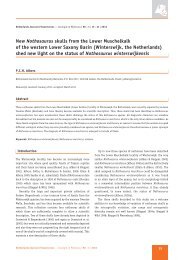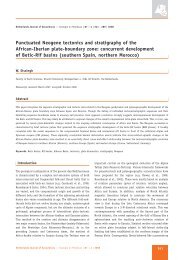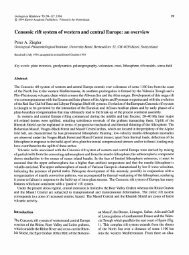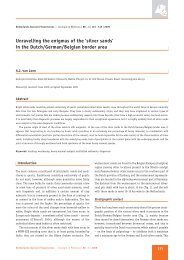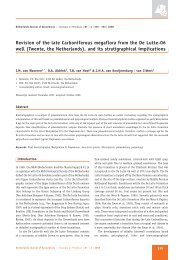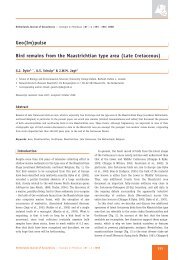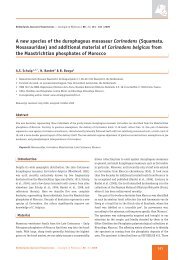Diagnostic sedimentary structures of the fluvial-tidal transition zone ...
Diagnostic sedimentary structures of the fluvial-tidal transition zone ...
Diagnostic sedimentary structures of the fluvial-tidal transition zone ...
Create successful ePaper yourself
Turn your PDF publications into a flip-book with our unique Google optimized e-Paper software.
Introduction<br />
During <strong>the</strong> past decades <strong>the</strong> <strong>tidal</strong> facies sensu stricto has been<br />
described in many papers, textbooks and conference volumes<br />
(e.g. De Raaf & Boersma, 1971, Ginsburg, 1975; Reineck &<br />
Singh, 1980; De Boer et al, 1988; Smith et al, 1991; Flemming<br />
& Bartholoma, 1995). The facies characteristics <strong>of</strong> <strong>fluvial</strong><br />
systems also have been published in large numbers and to a<br />
high degree <strong>of</strong> detail. The reader is referred to <strong>the</strong> many<br />
sedimentologic textbooks in general, and more particularly to<br />
proceedings <strong>of</strong> conferences on <strong>fluvial</strong> sedimentology (e.g.<br />
Miall, 1996; Collinson & Lewin, 1983; Ethridge et al, 1987;<br />
Marzo & Puigdefabregas, 1993; Fielding, 1993; Smith & Rogers,<br />
1999). By contrast, not very much is published on <strong>the</strong> <strong>fluvial</strong><strong>tidal</strong><br />
<strong>transition</strong> <strong>zone</strong>. This is remarkable because this <strong>zone</strong><br />
differs hydraulically to such a degree from <strong>the</strong> upstream<br />
<strong>fluvial</strong> and downstream estuarine <strong>zone</strong>, that one would expect<br />
it to be distinguishable as a separate <strong>sedimentary</strong> environment.<br />
One <strong>of</strong> <strong>the</strong> main characteristics <strong>of</strong> <strong>the</strong> <strong>transition</strong>al <strong>zone</strong> is<br />
<strong>the</strong> fluctuation in time <strong>of</strong> <strong>fluvial</strong> and <strong>tidal</strong> influence related to<br />
river flood waves. In this <strong>zone</strong> <strong>fluvial</strong> and tide dominated<br />
deposits thus may be expected to alternate in <strong>the</strong> vertical<br />
succession. The influx <strong>of</strong> fresh water is a key condition <strong>of</strong> <strong>the</strong><br />
estuarine environment. Deposits from <strong>the</strong> <strong>fluvial</strong>-<strong>tidal</strong> <strong>zone</strong><br />
may contain <strong>the</strong> only <strong>sedimentary</strong> indications <strong>of</strong> <strong>the</strong> existence<br />
<strong>of</strong> such an influx into a <strong>tidal</strong> basin. Deposits <strong>of</strong> <strong>the</strong> central or<br />
outer part <strong>of</strong> an estuary lack this signature. This also means<br />
that on outcrop scale, flood and ebb direction can only be<br />
determined in deposits <strong>of</strong> <strong>the</strong> <strong>transition</strong>al environment.<br />
Therefore, <strong>the</strong> recognition <strong>of</strong> <strong>the</strong> <strong>fluvial</strong>-<strong>tidal</strong> <strong>zone</strong> is <strong>of</strong> crucial<br />
importance to <strong>the</strong> <strong>sedimentary</strong> reconstruction <strong>of</strong> ancient<br />
estuarine environments. With transgression and regression, <strong>the</strong><br />
facies <strong>of</strong> <strong>transition</strong>al sediments will move up and down <strong>the</strong><br />
lower river reach. This makes it even more interesting to<br />
distinguish <strong>the</strong>m, as <strong>the</strong>y mark <strong>the</strong> far<strong>the</strong>st upstream extent<br />
<strong>of</strong> a transgression. Recognising <strong>the</strong>se deposits may <strong>the</strong>refore<br />
permit a more precise determination <strong>of</strong> <strong>the</strong> maximum flooding<br />
surface in sequence stratigraphy. (Shanley et al., 1992).<br />
Ano<strong>the</strong>r reason why <strong>the</strong> <strong>fluvial</strong>-<strong>tidal</strong> <strong>transition</strong> <strong>zone</strong> is so<br />
important is its great length in many low-gradient rivers,<br />
reaching tens or even hundreds <strong>of</strong> kilometers. As a result,<br />
substantial volumes <strong>of</strong> deposits may, in fact, be <strong>fluvial</strong>-<strong>tidal</strong> in<br />
character (Dalrymple and Choi, 2006). The failure to recognize<br />
subtle <strong>tidal</strong> influences in <strong>fluvial</strong> deposits might lead to<br />
erroneous paleogeographic reconstructions.<br />
In this paper it is aimed to pinpoint common characteristics<br />
that allow recognition <strong>of</strong> <strong>the</strong> <strong>fluvial</strong>-<strong>tidal</strong> <strong>transition</strong> as a<br />
separate facies entity in outcrops and boreholes. Our data<br />
record refers to observations, descriptions, photographs and<br />
lacquer peels <strong>of</strong> deposits <strong>of</strong> <strong>the</strong> Rhine and Meuse rivers that<br />
were exposed in large, temporary excavations. This implies<br />
that <strong>the</strong> validity <strong>of</strong> our study may be principally restricted to<br />
medium-sized rivers <strong>of</strong> <strong>the</strong> temperate climatic <strong>zone</strong>, such as<br />
288<br />
<strong>the</strong> Rhine, that pass through a meso<strong>tidal</strong> coastal plain estuary<br />
into <strong>the</strong> sea. The deposits we studied range in age from<br />
Pliocene (5 Ma) for deposits <strong>of</strong> <strong>the</strong> Lower Rhine Embayment in<br />
Germany (see Ziegler, 1990, for an overall paleogeographic<br />
reconstruction) to sub-recent (500 BP) for sediments exposed<br />
in pits in <strong>the</strong> western part <strong>of</strong> <strong>the</strong> Ne<strong>the</strong>rlands. Although <strong>the</strong><br />
drainage area <strong>of</strong> <strong>the</strong> Pliocene Rhine did not extend yet into<br />
<strong>the</strong> Alps (Gliese and Hager, 1978; Berendsen and Stouthamer,<br />
2001), outcrop evidence suggests a river with about <strong>the</strong> same<br />
discharge as <strong>the</strong> present Rhine. A larger annual rainfall during<br />
<strong>the</strong> Pliocene possibly explains this. At present <strong>the</strong> lower Rhine<br />
has a year-average discharge <strong>of</strong> 2300 m 3 s –1 . The Rhine follows<br />
a tectonic rift system were subsidence is more or less counterbalanced<br />
by sedimentation. Marine incursions alternate with<br />
more alluvial conditions. The river enters <strong>the</strong> sou<strong>the</strong>rn North<br />
Sea in a meso<strong>tidal</strong> setting. At <strong>the</strong> studied locations we<br />
deduced from historical data, from facies <strong>transition</strong>s and from<br />
<strong>sedimentary</strong> <strong>structures</strong> that <strong>the</strong> selected deposits were formed<br />
in <strong>the</strong> <strong>fluvial</strong>-<strong>tidal</strong> <strong>zone</strong>.<br />
A comparison between our record <strong>of</strong> <strong>sedimentary</strong> <strong>structures</strong><br />
from <strong>the</strong> Rhine and Meuse rivers and <strong>the</strong> scarce published record<br />
is difficult. Only Gosh et al. (2005) and Plink-Björlund (2005)<br />
provide detailed sedimentological descriptions. However, <strong>the</strong>ir<br />
geological background information only allowed a ra<strong>the</strong>r crude<br />
reconstruction <strong>of</strong> <strong>the</strong> depositional environment, leaving <strong>the</strong>ir<br />
assignment <strong>of</strong> <strong>structures</strong> to <strong>the</strong> <strong>fluvial</strong>-<strong>tidal</strong> <strong>transition</strong> <strong>zone</strong><br />
ra<strong>the</strong>r speculative. In o<strong>the</strong>r studies information is restricted<br />
to scattered statements and illustrations that tend to focus on<br />
large-scale architectural elements (e.g. Allen and Posamentier,<br />
1993; Shanley et al. 1992; Thomas et al., 1987; Yoshida, 2000;<br />
Eberth, 1996; Clifton, 1994 and Willis, 2000).<br />
The sedimentology <strong>of</strong> <strong>the</strong> <strong>fluvial</strong>-<strong>tidal</strong> <strong>transition</strong> <strong>zone</strong><br />
cannot be understood without considering <strong>the</strong> main changes<br />
in hydraulics and morphology that are related to <strong>the</strong> intrusion<br />
<strong>of</strong> <strong>the</strong> <strong>tidal</strong> wave and <strong>the</strong> seawater into this <strong>zone</strong>. This is <strong>the</strong><br />
subject <strong>of</strong> <strong>the</strong> next section. Then, we will propose a definition<br />
<strong>of</strong> <strong>the</strong> <strong>fluvial</strong>-<strong>tidal</strong> <strong>zone</strong>, which enables <strong>the</strong> recognition <strong>of</strong> this<br />
<strong>zone</strong> by sedimentological criteria. This is followed by a description<br />
<strong>of</strong> <strong>the</strong> studied outcrops showing <strong>the</strong> <strong>transition</strong>al deposits.<br />
Finally <strong>the</strong> diagnostic characteristics <strong>of</strong> <strong>the</strong> <strong>fluvial</strong>-<strong>tidal</strong> <strong>zone</strong><br />
will be discussed.<br />
The <strong>fluvial</strong>-<strong>tidal</strong> <strong>zone</strong> in <strong>the</strong> case <strong>of</strong> rivers<br />
like <strong>the</strong> Rhine<br />
Medium sized rivers, like <strong>the</strong> Rhine, which debouch into a<br />
meso-<strong>tidal</strong> or macro-<strong>tidal</strong> sea, usually have an estuarine lower<br />
course. Here, <strong>the</strong> generally winding, meandering river widens<br />
to provide space for <strong>the</strong> development <strong>of</strong> sand-bedded flood<br />
and ebb channels separated by shoals (Van Veen, 1950). The<br />
<strong>tidal</strong> wave is deformed by <strong>the</strong> presence <strong>of</strong> <strong>the</strong>se shoals. As a<br />
result <strong>the</strong> maximum flood velocity and discharge is reached<br />
when <strong>the</strong> shoals are being flooded. The maximum ebb discharge<br />
Ne<strong>the</strong>rlands Journal <strong>of</strong> Geosciences — Geologie en Mijnbouw | 86 – 3 | 2007



